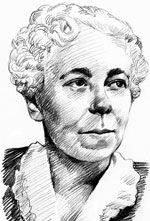Publication
Article
Psychiatric Times
Who Was Karen Horney?
Author(s):
Knowing from the start how a personality is organized, especially as theorized by Karen Horney-appreciating the primary and repressed moves of the patient, inner dictates, claims, idealized image, and intrapsychic defensive maneuvers-makes the help we offer most likely to succeed.

Years ago I worked with alcoholic men on the Manhattan Bowery, where 10 minutes per patient was the norm. I prescribed medication and attempted psychotherapy. I relied on energetic engagement and kept track of my patients’ idiomatic verbal usages, corrected wrong cognitions, and recommended better behaviors. I incorporated psychoanalytic principles-Freudian principles as modified by Karen Horney (pronounced Horn-eye). With rueful affection, my patients, recently discharged from the drying-out unit, called my treatment turnstile psychiatry.
As the drafts of DSM-5 suggest, we are moving still more forcefully to knowing our patients through symptoms that cut across constellations of disorders. Yet despite our sophisticated nosologies and psychopharmacological remedies, our patients still want us to know them. In this, they are no different from patients who see an internist or surgeon. We are psychiatrists; our patients expect more from us. But our time with each of them is short. Horney can help.
Karen Horney (1885-1952), an early follower of Freud, was trained in Berlin. In 1932, she relocated to Chicago to become Associate Director of the newly formed Chicago Institute for Psychoanalysis. Several years later, she joined the New York Psychoanalytic Institute. Yet all through the 1920s and 1930s, she was becoming disenchanted with Freudian orthodoxy-chiefly its lofty regard of penis envy and the Oedipus complex. She hammered away at Freud’s endorsement of a conservative cultural belief system that gave male superiority an endorsement from biology. She began her own school, which energized what would soon play a major role in the Neo-Freudian orientation to psychoanalytic or, more inclusively, “psychodynamic” thinking.
Psychodynamic psychiatry
The who of the patient is foremost in psychodynamic psychiatry. Who this person is precedes as foundational the complaints and the treatments we later recommend. It includes unconscious elements that interact beyond the patient’s awareness and that contribute to personality organization and symptom development. In the usually brief sessions we have with our patients, we want to engage them. We want them to feel engaged with us.
Many readers of Horney’s books find themselves in her pages. They feel that someone out there knows them. In applying the tenets of her orientation and the simple humanity that runs through her work, we become engaging to our patients. They find themselves through the treatment we offer, even when we are constrained by the turnstile psychiatry that so many of us now find ourselves practicing.
Horney’s theories
For Horney, a child grows freely and well to the extent that he or she feels security and genuine self-esteem. To the extent that the child falls prey to adverse influences, he or she develops a deep insecurity, what Horney called basic anxiety-the feeling of being helpless and alone in a world experienced as potentially hostile.
Basic anxiety is intolerable if it is intense and sustained. The child must act to allay it. He may feel the need to see things differently to reduce the sense of threat. Horney framed these efforts at reorientation as interpersonal moves. The child may move toward others by showing a clinging neediness, dependency, and self-effacement if loving submission appears to be the safest strategy. Or, the child may move against others by showing aggression, expansiveness, grandstand behavior, competitiveness, control, contempt, and exploitation of others. Included within this general orientation are tendencies toward narcissistic grandiosity, perfectionism, arrogance, and vindictiveness. Finally, the child may move away,or detach himself, from others, showing efforts to disengage and thereby avoid conflict between the tendency to submit and the tendency to dominate.
These moves are interpersonal as well as intrapsychic. The intrapsychic correlates (which encompass the traditional concept of transference) of what begin as interpersonal moves account for a rich understanding of psychic process. When the child suffers from excessive insecurity, these moves-toward, against, and away-become increasingly fixed and rigid. Generally, one move is elevated above the others. The entire spectrum of attitudes, beliefs, needs, qualities, and sensitivities that is consistent with the strategy selected becomes rigidly organized and excessively valued.
The person who learns that security is achieved and basic anxiety allayed by moving toward others comes to overvalue love, charity, kindness, self-sacrifice, and intimacy. He may show kindness even when it is evident that the object of kindness sees generosity as a clear sign of weakness and stupidity. The person who feels secure only when in overt control may come to value strength, power, money, and prestige. Such a person sulks or rages when he fails to win yet another award or when a spouse does not jump to his every wish, even those unspoken. The person who feels safe when detached comes to value freedom and serenity. He may care about a certain issue but does not want to “get involved.”
When the neurotic process is under way, restrictions are imposed. Ways of feeling, thinking, and acting that are experienced as at odds with the primary solution are automatically and unconsciously rejected, but they do not disappear. They remain alive in the unconscious and constantly struggle for expression against the primary move.
The pressure created by these 3 orientations provides the dynamics that is so crucial to understanding the person in clinical context and making sense of inconsistencies. Hence, for example, the person who rigidly moves against others and endorses strength is likely to experience softer feelings as threatening. The person rejects such feelings and is alienated from them. Yet they continue to operate unconsciously and result in behaviors, dreams, and errors in daily living that seem very much at odds with the person’s preference.
These opposing strivings generate much of the inner unconscious conflict that surfaces as the basis for psychopathology. The self-effacing person, for example, may unknowingly exert considerable control by inducing guilt in others. Or, the person seeking to control his or her feelings may be alarmed by their sporadic eruption. The internal conflict generated by these opposing strivings that have become not only rigid and fixed but also insatiable, compulsive, and indiscriminate is what Horney called basic conflict. In addition to the defensive operations, such as projection, denial, rationalization, and dissociation, Horney added idealization.
The person evolves an idealized image. The orientation selected is elevated to a status of utter grandiosity. The person is not merely a kind person, but the kindest person; not merely a tough person who can negotiate any business deal, but the toughest son of a bitch you can imagine; not merely a person who enjoys freedom, but one who is-like the song says-“King of the Road.” This leads to a search for glory. The actual self is in profound conflict with the glorified self-the self one yearns to be. One may hate the actual self for falling so far short of the idealized self.
The quest to actualize the idealized self, like so much else, is largely unconscious. At any moment, the individual or the observer may catch sight only of its shadow. One critical way by which we recognize the neurotic process is in the irrational claims or entitlements the neurotic person makes on others and, importantly, on himself. These claims on self constitute inner dictates, a tyranny of the shoulds. Guilt, self-recrimination, compulsive behavior, critical attitudes toward others, fear of critical attitudes from others, inhibitedness, loss of spontaneity in feeling and action, and specific Axis I disorders may, with consideration of biological factors, result from such inner tyranny.
Beyond what we now consider organic determinants, in Horney’s terminology, our patient seeks help because the unconscious dynamic forces-a mix of feelings, thoughts, and customary behaviors-are not working. With medications and one or another form of psychotherapy, the psychiatrist is supposed to help fix matters. Sometimes that is possible, and it may even lead to an excellent outcome. Knowing from the start how a personality is organized, especially as theorized by Karen Horney-appreciating the primary and repressed moves of the patient, inner dictates, claims, idealized image, and intrapsychic defensive maneuvers-makes the help we offer most likely to succeed.
References:
For More Information
• Horney K. Final Lectures. In: Ingram DH, ed. New York: WW Norton and Company, Inc; 1987. Edited transcript of 1952 lectures on technique by Karen Horney with introduction and notes.
• Horney K. Neurosis and Human Growth: The Struggle Toward Self-Realization. New York: WW Norton and Company, Inc; 1950.
• Horney K. Our Inner Conflicts. New York: WW Norton and Company, Inc; 1945.






